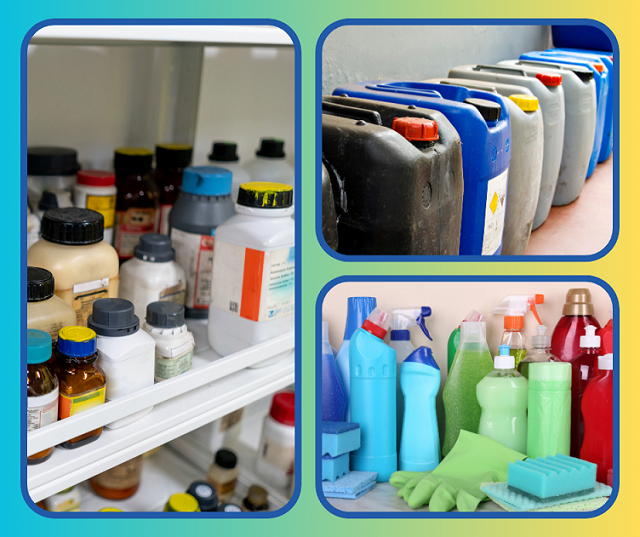Keep your hazardous products stored safely at home and while transporting them. Here’s how.

Just about everyone has items with hazardous materials at home. If you’re reading this on a phone or laptop, you might be holding such an item right this very moment!
But with a few simple precautions around storing and moving these materials, you can easily protect yourself from toxic exposures.
Knowing which household products are potentially hazardous is the first step. Look for the words CAUTION, WARNING, DANGER, or POISON on the label.
If you’re a King County resident, it’s also good to know all the places you can bring your hazardous waste for safe disposal: our year-round disposal sites, the traveling Wastemobile, and various participating locations in programs such as PaintCare, Call2Recycle, LightRecycle Washington, and E-Cycle Washington.
But before you drop off your hazardous waste for disposal, keeping it properly stored will not only help your disposal visit go more smoothly, it will also help keep you and your home safe.
Here are a few safe storage tips for common household hazardous materials.
General tips
- When possible, keep products sealed in the original container with the original label.
- If products are moved to a new container, label the container and seal it to prevent spills.
- Use containers that are 5 gallons or smaller in volume.
- Do not mix products. Keep each in separate containers.
Do not mix motor oil with other products like gasoline, antifreeze, brake cleaner, or solvents. Thisprevents potentially dangerous chemical reactions, and it ensures products can be properly disposed.
Individually package or put tape on the ends of batteries to prevent a fire hazard. Avoid throwing batteries in the garbage – some locations in our region have banned this, and it can contribute to toxic materials leaking into our environment.
Check whether the charcoal is match-light. If it’s not, it can go in the garbage. Match-light charcoal can be securely stored and brought to a hazardous waste collection site.
E-cigarettes, vape cartridges, and cigarettes
Separate the liquid container from the battery pack before taking the items to a collection location. These devices should not be thrown in the trash, and any liquid waste from them should not be flushed down the drain.
Solid fertilizers with no pesticides can go in the garbage. Liquid fertilizers with no pesticides can be solidified using dirt, kitty litter, paper towels, or other absorbent materials and put in the garbage. Fertilizers with pesticides or herbicides, often called weed and feed, are accepted at hazardous waste collection sites.
Dry, empty containers, including aerosol cans, can go in the garbage (no need to rinse). Do not recycle fertilizer containers.
Dispose used fuel and oil filters in the garbage after you drain them.
To drain filters, turn the filter upside down to empty the fluid into an airtight container. Allow the drained filter to dry out for 2 days. Once dry, the drained filter can go in the garbage. The fluid can be taken to a disposal location.
Fluorescent light ballasts and bulbs
Older fluorescent light ballasts may contain polychlorinated biphenyls (PCBs). Double-bag all light ballasts and seal with duct tape. Wear gloves while handling PCB ballasts. Handle leaking PCB ballasts with extreme caution to avoid exposure and contamination.
Put broken bulbs in a plastic bag or closed container.
Double-bag all paint chips and seal bags with duct tape.
Got questions about safe storage? Email us at haz.waste@kingcounty.gov or call the Haz Waste Help Line at 206-296-4692. Help Line hours are Monday to Saturday, 9 a.m. – 5 p.m., except holidays.

 Translate
Translate